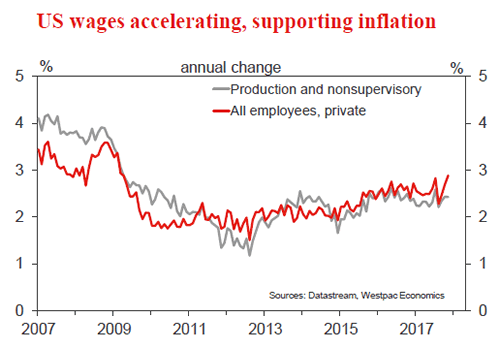Week beginning 5 March 2018
- RBA on hold: AUD to weaken through 2018 and 2019.
- RBA: March policy decision, Governor Lowe speaks.
- Australia: GDP, company profits, current account, trade, retail sales, dwelling approvals.
- NZ: building work, retail card spending.
- China: CPI, foreign direct investment, trade balance.
- Euro Area: ECB policy decision, Italian General Election, SPD coalition vote results.
- US: nonfarm payrolls, Federal Reserve Beige Book.
- Central banks: BoC policy decison, BoJ policy decision.
- Key economic & financial forecasts.
Information contained in this report current as at 2 March 2018.
RBA on hold : AUD to weaken through 2018 and 2019
The Reserve Bank Board meets next week on March 6. Of course we expect there will be no change in the overnight cash rate.
We also do not expect to see any significant change in the Governor’s rhetoric from last month.
The GDP Report for the December quarter – which we expect will show that annual growth has slowed from 2.8% in the year to September to 2.5% – will not print until March 7 and although the Bank will be anticipating a soft result, this is unlikely to dissuade it from its current view that GDP growth in 2018 will lift to 3.25%.
Readers should be aware that Westpac has reviewed its currency forecasts and, while continuing to see an AUD low of USD 0.70 in 2019, has pushed out the timing to September 2019 from March. Below I set out detailed reasoning behind our AUD views.
We expect to see the AUD gradually fall through 2018 and 2019 against the USD.
The AUD is likely to hold around USD 0.77 to June before falling to USD 0.74 by year’s end.
In 2019 it is expected to reach USD 0.70 by September and to hold around that level to year’s end.
These forecasts broadly reflect our Fair Value model after making some adjustments for our own judgements particularly around capital flows that may not be fully explained by commodity prices and interest rates.
The key drivers behind our views are: a fall in Australia’s commodity export prices, and an unprecedented sharp negative widening in the AUD/USD interest rate differential as US rates rise sharply. Furthermore, we anticipate a reversal of the current trend for the USD to weaken against the other majors.
The key to commodity prices lies with China. China’s Chairman Xi recently identified pollution; poverty and excessive leverage as China’s key policy challenges.
Our commodity price views have been based around the expected slowdown in China’s credit growth (particularly in the unregulated so-called shadow banking sector) firstly squeezing commodity speculators who currently hold substantial stocks of iron ore and secondly slowing investment particularly in major transport projects. These projects are typically associated and funded by local governments, usually outside the regulated banking sector. They place considerable reliance on funding from the shadow banking system. In addition, housing activity, which also partly relies on the shadow banking sector, looks set to remain quite flat over the next few years.
While these are clear factors which are likely to weigh on commodity prices, China’s anti-pollution policies have been supporting iron ore and coking coal prices. Small high polluting mines/furnaces have been closed down with some production moving to larger more efficient operations. These larger producers have been using a higher share of quality imported iron ore, effectively holding up import prices despite lower production.
The dominant iron ore exporters – Australia and Brazil – have not been significantly lifting production to take advantage of higher prices and widening margins.
These dynamics will continue to support prices for some time yet. Nevertheless we expect that over the course of the second half of 2018 and through 2019, the downward pressures associated with a slowing economy and tighter credit conditions in China will gradually take their toll on both iron ore and coal prices.
We would also expect some downward price pressure from a lift in supply from the dominant exporters. Margins remain extremely attractive and we expect producers, particularly the Brazilians (around 30% of the majors’ production) to lift production.
Overall, we are expecting a cumulative fall (in USD’s) in Australia’s Commodity Price Index of around 25% between June 2018 and December 2019. That includes around a 6% appreciation in the USD Index.
The USD Index has been under considerable recent pressure (down 15% from its peak in late 2016 to its low in mid-February). Recently it has lifted by around 2% partly reflecting the sharp rise in US bond rates.
While I was recently in the US visiting real money managers and officials, the common theme was that the recently enacted Tax Cuts and the $300 billion spending package were poorly timed. They coincided with the US economy at full employment and building momentum. The likely resulting inflation pressures and a rising FEDERAL FUNDS RATE were expected to significantly boost bond rates. In turn, higher bond rates are likely to reverse the recent weakness in the USD.
Readers will be aware that Westpac expects a considerable widening in the negative Australia/US interest rate differential as the FEDERAL RESERVE continues to raise rates and the RBA remains on hold.
Markets move on expectations.
They are currently pricing in a yield differential between Australia and the US overnight rates of around negative 50 basis points by end 2018 whereas Westpac expects negative 65 basis points. They are expecting a differential of around negative 30 basis points compared to Westpac’s forecast of negative 112 basis points by end 2019.
Our expected differential in 2019 has no precedent raising the prospect that the downward pressure on the AUD could be under stated in our forecasts.
We anticipate that as markets adjust to Westpac’s rate differential outlook there will be further downward pressure on the AUD. This effect is likely to be more pronounced in 2019 than 2018 with the gap between Westpac’s view and the market narrowing significantly in 2019. Note that only a few weeks ago markets were only expecting a negative differential of 28 basis points by end 2018. They have moved significantly towards the Westpac view. But there is more to come.
Falling commodity prices; widening negative yield differentials and a stronger USD all point to a weaker AUD through the remainder of 2018 and 2019.
The week that was
Market participants and the RBA have long been waiting for an uplift in business investment. In the latest CAPEX release, there is cause for optimism (albeit measured). While the quarterly outcome which feeds into GDP disappointed, this came as a result of a latecycle bout of weakness in mining investment, as key gas projects draw near completion. More importantly for the outlook was the 1.8%, 10.4%yr gain for CAPEX across the non-mining economy. This upswing is being driven by construction work, particularly non-residential activity to meet the needs of a growing population. Victoria is the most notable beneficiary by state.
In addition, the forward estimates for 17/18 and 18/19 financial years were on the upside. See chart of the week for further detail.
A consequence of the above CAPEX disappointment in the December quarter (and last week’s construction release) is that we have shaved our Q4 GDP forecast for next week by 0.1ppt to 0.5%, 2.5%yr. Of the contributors to the overall forecast, the positives include: a modest bounce for consumption 0.7%, 2.1%yr; a 1.5%, 7.0%yr gain for business investment; and a gain for public spending of 0.6%, 4.4%yr. Net exports will however subtract 0.6ppts in the quarter. Looking to 2018, the sub-trend pace of expansion is set to persist as the consumer is restrained by weak wages growth, and the home building downturn continues.
Important to both of these factors, house price growth remained in a downtrend in February. The national composite has fallen 1.3% since October, led by declines in Sydney. Here, annual price growth turned negative for the first time since late 2012, – 0.5%yr. In Melbourne, annual price growth has instead held up, 6.9%yr in February. Recent data on auction clearance rates point towards a stabilisation in prices in the months ahead. For an in-depth assessment of Australian housing markets, see our latest Housing Pulse report.
Turning to the US, new FOMC Chair Jerome Powell’s first Congressional testimony was the focus for markets this week. In his first appearance, before the House of Representatives Committee, he struck a confident and committed tone, emphasising that since the December FOMC meeting, the economy had strengthened on the back of tax and spending initiatives from the government and given continued gains for employment and confidence. The market debate quickly turned to whether the next set of forecasts from the Committee would point to four rather than three rate hikes in 2018. However, a subsequent repeat performance before the Senate carried a more cautious tone on wages and inflation, and this saw market pricing revert to where it began the week – President Trump’s trade announcement was also a contributor (see below). It is very clearly the case that US interest rates are on the way up. Debate over the timing and the overall scale of the increase will continue through 2018; how the market reacts to each rise holds great significance. We continue to expect three hikes this year and another two in 2019, but see the risks skewed to the upside.
A new point of tension that has come to the fore this week is trade relations. Overnight President Trump announced tariffs on steel (25%) and aluminium (10%) imports to the US in pursuit of greater production and employment in the US. Only time will tell whether this is a one-off or the first in a succession of protectionist measures. It will also be critical to assess how other countries respond, either through challenging the tariffs via the World Trade Organisation, or by responding with their own measures. Along with the fiscal uncertainty being created by the tax and spending initiatives (which could add near 15ppts to US government debt over the decade, if sustained), trade will be a key area of uncertainty for the US economy (particularly the US dollar) in 2018.
One of the countries that is likely most affected by these measures is China. Data to hand for 2018 suggests that, while authorities are having great success reducing speculation absent a substantial decline in residential construction activity, Chinese growth is still very susceptible to global growth trends. External demand provided a material windfall to China in 2017; but this will not be the case in 2018. Should additional protectionist measures be imposed by the US or others, the headwinds will grow stronger still.
Lunar new year holidays make assessing Chinese data and that of other Asian nations difficult at this time of year. However, from the official China PMI’s, there is some evidence that underlying momentum in manufacturing topped out at the end of 2017, and is set to slow in 2018. Being more domestically focused, growth in services has held up. For the rest of Asia, conditions are strong. This is particularly the case for Japan which is benefitting not only from a comparatively cheap currency but also its strong, export-focused corporate sector.
Chart of the week: Business investment plans
The ABS business plans survey suggests that the upturn in business investment that emerged in 17/18 will extend into 18/19.
Estimate 5 for investment in the current financial year implies a 2.5% gain on the 2016/17 year, as non-mining investment offsets the dissipating drag from mining. The first estimate for the 2018/19 financial year suggests this uptrend will continue, with a 3.5% gain overall and an 8.0% rise for non-mining spending expected. The mix remains skewed to buildings and structures (13.5%) over equipment (2.0%). Note that early estimates for the coming financial year are highly volatile. Further, the CAPEX survey is only a partial representation of business investment. That said, to the extent that it omits key growth industries, the estimates are more likely to be skewed to the downside than upside.
Looking to next week, RBA Governor Lowe is giving a speech on the "The Changing Nature of Investment" on Wednesday Mar 7.
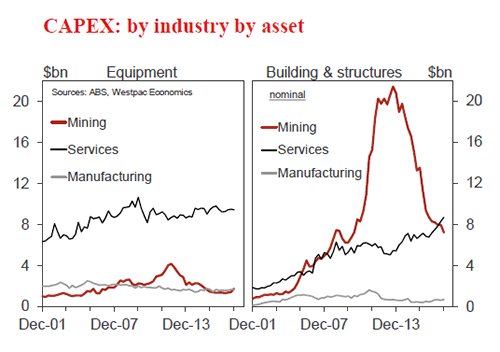
New Zealand: week ahead & data wrap
The start of 2018 has seen divergent conditions across the New Zealand economy. Households have hit the ground running, and spending looks like it will remain firm for some time yet. In contrast, gauges of business sector activity remain soft.
Households resilient
Looking first at the household sector, the strength in spending that we saw at the close of 2017 has carried through into early 2018. Retail spending rose by a solid 1.4% in January, including strong gains in categories such as durables and hospitality. We expect that the February figures (out next week) will show that spending is continuing to grow at a healthy pace.
Contributing to this firmness in spending have been the recent pick-up in the housing market and the resilience in net migration. Both of those factors were key drivers of demand growth in recent years. And while they are now off their earlier peaks, they remain in supportive territory. However, these are also areas where we expect conditions to change markedly over the next few years, and over time that will have a dampening impact on spending.
On the housing front, we have seen a bit of a second wind over the past few months as election related uncertainty has faded and mortgage rates have fallen. With fixed mortgage rates falling further in recent weeks, and the Reserve Bank slightly easing its LVR mortgage lending restrictions, we expect the current market buoyancy will continue for a few more months. Housing market conditions have a close relationship with household spending in New Zealand, particularly for durable items like home furnishings. And with both home sales and prices lifting in recent months, it’s no surprise that housing spending has remained firm.
However, even with the recent pick-up, the housing market is looking softer than it did this time last year, especially in Auckland where sales are down 20% over the past year and prices have been flat. Going forward, we expect the current resurgence will eventually give way to an extended period of soft housing market activity. In part, this is because we expect fixed mortgage rates will creep higher later this year. On top of this, the Government will be rolling out a range of policies aimed at dampening housing market conditions over the next few years including restrictions on foreign buyers, an extension of the ‘bright line’ test for capital gains, and the ring-fencing of losses on investment properties. This combination of polices will result in a markedly different set of housing market conditions than New Zealand has experienced in recent years, with investor demand likely to be significantly curtailed.
One of the other big drivers of household spending in recent years has been rapid population growth on the back of record levels of net migration. Through mid-2017, it looked like the migration cycle had peaked, as arrivals levelled off and departures trended upwards. However, net migration has picked up again over the past few months as arrivals have pushed higher. This has seen annual net migration stabilising at a very high level of 70,000. The key question is whether we will see net migration resuming its downtrend over the coming months. Movements of New Zealanders in and out of the country have remained stable, and we are continuing to see a gradual increase in departures of non-New Zealanders. The big uncertainty relates to new arrivals. January’s pickup in arrivals was large, and it wouldn’t be surprising to see some pull back next month. In addition, we are seeing firmer conditions in other countries, which will make New Zealand look relatively less attractive. Putting this altogether, we continue to expect that net migration will decline over the next few years, however this may be quite gradual.
Business nervousness persists
Turning to the business sector, things are looking very different. Slowing GDP growth and the changing political backdrop saw business confidence fall sharply in late-2017. And while we have seen some recovery in early-2018, businesses remain deep in pessimistic territory.
Importantly, it’s not just confidence about the general economic environment that has taken a knock. Activity indicators from both the PMI and PSI remain down on their pre-election levels. That includes a pullback in new orders, suggesting that we could see further softness over the months ahead.
With businesses still nervous about the economic backdrop, we’ve been factoring in a period of softness in investment spending over the coming year. However, due to the lags associated with capital spending, we don’t expect to see this coming through until mid to late 2018. Indeed, this week’s trade figures actually showed that imports of capital equipment remained firm in January.

Data Previews
Aus Q4 company profits
Mar 5, Last: – 0.2%, WBC f/c: 4.0%
Mkt f/c: 1.5%, Range: -1.5% to 6.0%
- In Q3, company profits were little changed, -0.2%, to be 1.7% higher for the year to date. Falls in mining (on lower commodity prices) and real estate (as housing cools) were offset by gains across business service sectors.
- For Q4, we anticipate a rise of 4.0%qtr, inflated by higher prices boosting the value of inventories (which is booked as a profit). However, on a national accounts basis (abstracting from this valuation adjustment) a more modest rise is likely, around +1.3%.
- Mining profits are expected to rise by almost 6% in Q4, having received a boost from higher commodity prices.
- Non-mining profits are trending higher, supported by a strengthening of domestic demand, but are mixed by industry, given an uneven expansion. For Q4, we anticipate a rise of around 3% (incorporating the artificial boost from the inventory valuation adjustment).
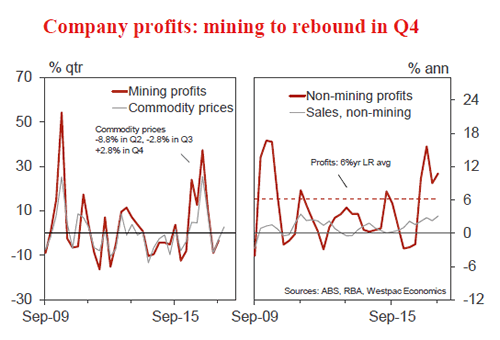
Aus Q4 inventories
Mar 5, Last: 0.2%, WBC f/c: 1.0% (0.3ppts)
Mkt f/c: 0.5%, Range: -0.3% to 5.6%
- Inventories were volatile in 2017, in part due to the impact of weather disruptions over the first half of the year.
- In Q3, inventory levels broadly stabilised, expanding by 0.2% ($0.3bn), to be 1.0% above the level of a year earlier. Inventories added 0.2ppts to activity in the period.
- For Q4, we expect a return to volatility, with a 1.0% ($1.6bn) rise in inventories, adding 0.3ppts to activity.
- Notably, imports of goods (ex fuel) spiked in the month of December, up 6% ($1.3bn), suggesting an abnormal clustering of shipments ahead of the new year. Some of these imported items will show-up initially as inventories
- Another consideration, mining inventories contracted sharply in Q3, -$0.7bn (in part to facilitate a lift in export shipments), a result that is unlikely to be repeated in Q4.
- As always with inventories, we note the elevated uncertainty.
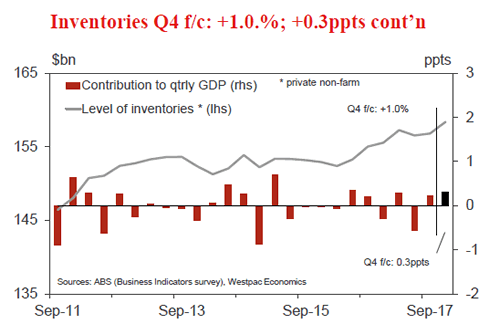
Aus Jan dwelling approvals
Mar 5, Last: – 20%, WBC f/c: 1.0%
Mkt f/c: 5.0%, Range: 0.0% to 11.0%
- Dwelling approvals retraced spectacularly in Dec, dropping 20% as a an expected wind-back in Melbourne high rise approvals, after a big spike in Nov, was compounded by weakness elsewhere. Looking through recent volatility, trend approvals are again moving lower with non high rise approvals in Q4 down 3.5%yr. Assessing trends in the erratic high rise segment is much trickier but site purchases continue to point to this segment taking a further leg lower over the course of 2017-18.
- Latest housing finance data point to a slightly firmer trend in non high rise approvals in coming months. Although high rise should remain weak, this is likely to see a marginal 1% rise in total approvals in Jan. As always, housing data should be treated with extra caution around the summer holiday low period as seasonal adjustment can amplify monthly volatility.
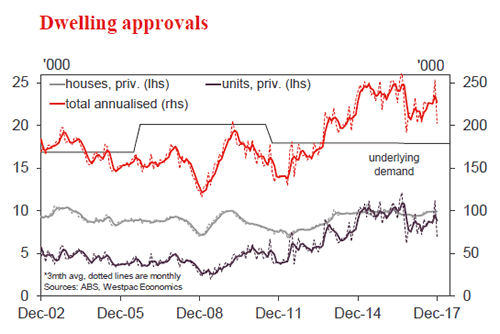
Aus Jan retail trade
Mar 6, Last: – 0.5%, WBC f/c: 0.4%
Mkt f/c: 0.4%, Range: 0.1% to 0.6%
- Retail sales had a bumpy finish to 2017 with a solid recovery in Sep-Nov from weakness mid year giving way to a 0.5% decline in the Dec month. The iPhone X launch and increasingly popular ‘Black Friday’ sales were positives but may also have shifted the timing of sales. Alongside this monthly volatility, the quarterly data showed significant price declines for non-food categories associated with the launch of Amazon’s Australian operations. Note that Amazon’s Australian retail sales are in scope for the retail survey and should appear in sales estimates going forward.
- The wider consumer backdrop was reasonably positive at the start of 2018 with sentiment posting its best Jan read since 2010. Incomes continue to be supported by strong job gains but undermined by weak wage growth. Private sector business surveys suggest retailers saw a small lift. On balance we expect Jan retail sales to show a 0.4% gain, the inclusion of Amazon sales likely to give some boost.
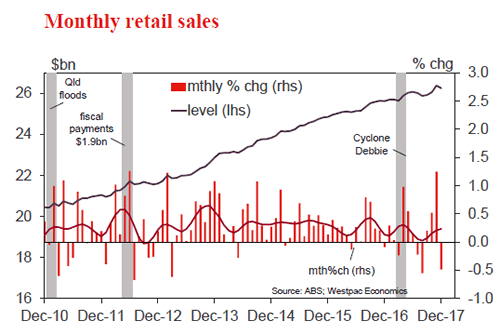
Aus Q4 net exports, ppts cont’n
Mar 6, Last: 0.0, WBC f/c: -0.6
Mkt f/c: -0.6, Range: -0.9 to 0.6
- Net exports, as with inventories, were volatile in 2017, in part due to weather disruptions during the first half of the year.
- In Q3, net exports were neutral for activity, with both import and export volumes expanding by 1.9%.
- For Q4, net exports were a major headwind, subtracting an estimated 0.6ppts from activity.
- Imports rose an estimated 0.6% in Q4 to meet rising domestic demand.
- Exports stumbled, contracting by an estimated 2%, to be only 1.5% above the level of a year ago. Cereal shipments retreated from historic highs associated with the earlier bumper harvest, while coal exports fell in part due to temporary disruptions, including strike action.
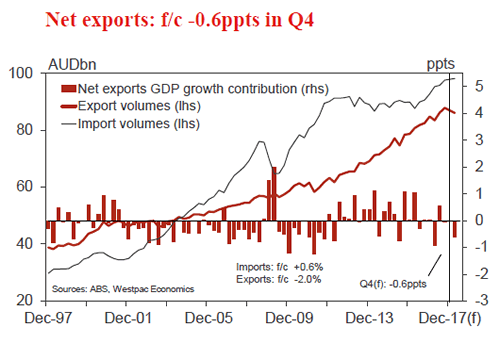
Aus Q4 current account, AUDbn
Mar 6, Last: -9.1, WBC f/c: -13.0
Mkt f/c: -12.2, Range: -13.8 to -9.0
- During 2017, Australia’s current account deficit has been well contained, at 2.0% of GDP in Q3, supported by elevated commodity prices boosting export earnings.
- For Q4, the current account deficit is expected to widen from $9.1bn to $13.0bn, representing 2.9% of GDP.
- Key to this, the trade position deteriorated in Q4. The trade balance swung from a surplus of $2.0bn in Q3 (revised lower from $3.1bn) to a deficit of $0.6bn in Q4. Exports stumbled at the same time as import volumes continued their upward trend (see above). As to the terms of trade, this was broadly flat in the period, we estimate.
- In Q4, the net income deficit is expected to edge higher to $12.4bn from $12.2bn. Note that the deficit has deteriorated from a 2016 average of $8.5bn/qtr as higher commodity prices translate into better returns for offshore investors.
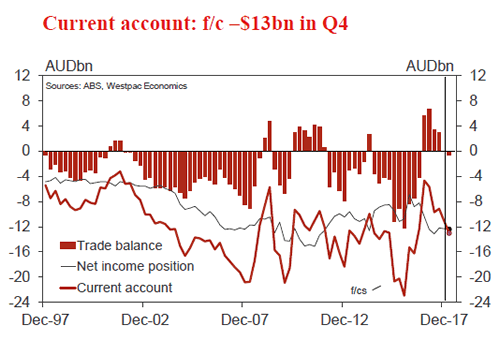
Aus Q4 public demand
Mar 6, Last: 1.5%, WBC f/c: 0.6%
- Public demand is a key growth driver, expanding at an above trend pace in 2015, 2016 and 2017, with annual growth at 4.8%, 5.5% and 4.4% (we estimate), respectively.
- An upswing in public investment is underway, lifting from recent lows, as governments commit to additional projects – particularly transport infrastructure – now that earlier fiscal pressures at the state level have receded.
- In Q3, public demand increased by 1.5%, boosted by a sharp 7.4% jump in investment (which is often volatile quarter to quarter) but constrained by a rise of only 0.2% for public consumption (which accounts for 80% of public demand).
- For Q4, we anticipate a more modest rise in public demand of 0.6% as investment consolidates in the period.
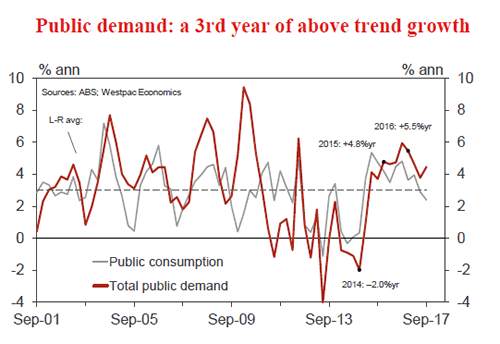
Aus Mar RBA decision
Mar 6, Last: 1.50% WBC f/c: 1.50%
Mkt f/c: 1.50%, Range: 1.50% to 1.50%
- The RBA will almost certainly decide to hold rates unchanged at their March meeting – as they have since they last cut rates in August 2016.
- The Governor has stated that: "further progress in reducing unemployment and having inflation return to target is expected, although this progress is likely to be gradual".
- The case for patience has been reinforced by the latest price and wage updates – core inflation is only 1.6% annualised over the past half year and private wages growth is still at historic lows.
- Moreover, tighter lending standards have been helpful in containing the build-up of risk in household balance sheets.
- We continue to expect the RBA to leave the cash rate unchanged at 1.50% throughout 2018 and 2019.
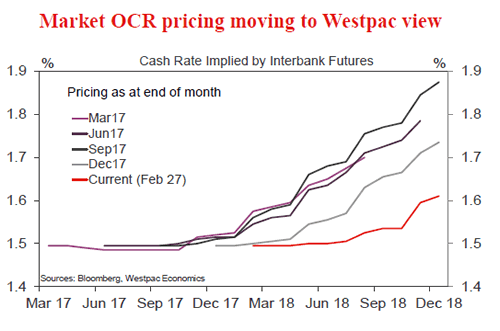
Aus Q4 GDP
Mar 7, Last: 0.6%qtr, 2.8%yr; WBC f/c: 0.5%qtr, 2.5%yr
Mkt f/c: 0.5%, Range: 0.1% to 0.8%
- Real GDP expanded by a forecast 0.5% in Q4, with domestic demand up 0.7%, inventories adding 0.3ppts, with a sizeable partial offset from net exports, -0.6ppts as exports stumbled, -2%qtr. Annual real GDP growth moderates to 2.5% from 2.8%.
- Consumer spending improved, up a forecast 0.7%, after a rise of only 0.1% in Q3. Housing declined further, -1%qtr, following a strong and extended upswing.
- Business investment, +1.5%qtr, advanced having turned the corner in 2017, with a diminished drag from the mining investment wind-down and a lift in non-mining construction to meet the needs of a growing population. Public demand, +0.6%qtr, +4.4%yr, is expanding at an above trend pace, centred on an investment upswing. • See our preview bulletin for further details.
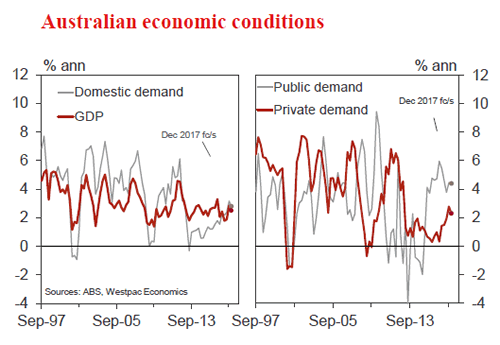
Aus Jan trade balance, AUDbn
Mar 8, Last: -1.4, WBC f/c: 0.6
Mkt f/c: 0.2, Range: -1.5 to 0.8
- In December, Australia’s trade balance slumped to a deficit of $1.4bn, deteriorating from a $36mn surplus in November. Imports spiked 6.0% (+$1.9bn) in the month, suggesting an abnormal clustering of shipments ahead of the new year.
- For January, we expect a sharp reversal to a $0.6bn surplus. We highlight the uncertainty around trade forecasts, particularly in cases such as this, when the view is centred on a judgement on imports.
- The import bill is expected to decline by $1.9bn (-5.5%), fully unwinding December’s spike. Contributing to the January reversal are lower prices owing to the rise in the currency, up 2% on a TWI basis and 4% higher against the US dollar.
- Export earnings are forecast to edge higher, up 0.2%, $0.1bn. A rise in iron ore exports, on higher prices and volumes, is expected to be largely offset by a moderation in coal.
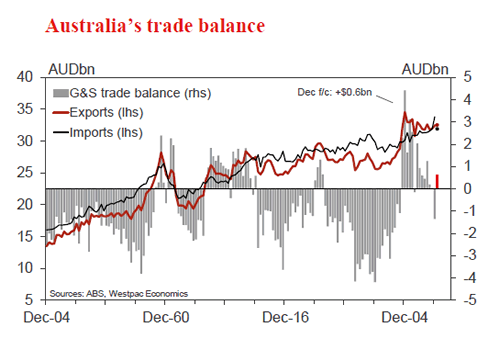
NZ Q4 building work put in place
Mar 7, Last: +2.7%, Westpac f/c: +1.6%, Market f/c: 1.0%
- Construction activity picked up in September, rising by 2.7%. This was underpinned by a lift in residential construction that offset softness in non – residential activity.
- The aggregate building figures are masking stark regional differences in construction. Building activity in Canterbury is continuing its gradual post – quake wind – down. At the same time, activity is firming in other regions, including Auckland.
- The level of construction activity is elevated and there is a large pipeline of planned work. However, rising building costs, stretched capacity in the building sector, and difficulties accessing credit are all providing some brake on how quickly building activity can ramp up to meet demand. As a result, we expect a modest 1.6% rise in construction through the December quarter. The key area of risk is non – residential construction, which could surprise to the upside following its recent softness.
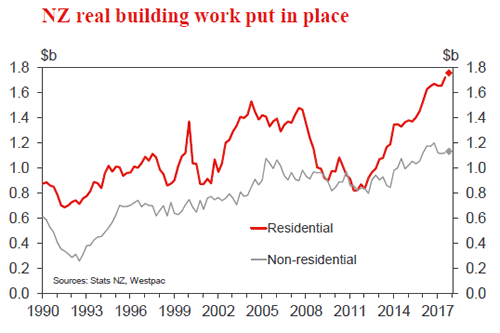
NZ Feb retail card spending
Mar 9, Last: +1.4%, WBC f/c: +0.6%, Market f/c: 0.3%
- Retail spending posted a solid rise of 1.4% in January, underpinned by a lift in durable spending. Stats NZ have attributed this to spending associated with increased purchases of ‘back to school’ supplies, which increasingly include electronic devices. However, we have also seen a second – wind in the housing market that is likely to have boosted spending on durable items. Spending on hospitality was also up.
- With mortgage rates edging down, renewed strength in the housing market, and migration remaining firm, we expect to see spending increase by 0.6% in February. Spending is expected to be up in most categories (though we are likely to see a pullback in durables spending following last month’s strong gain).
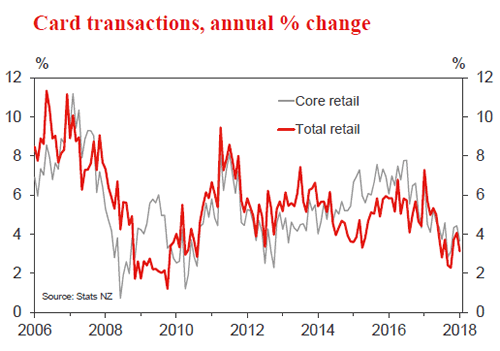
US Feb employment report
Mar 9, nonfarm payrolls, last 200k, WBC 230k
Mar 9, unemployment rate, last 4.1%, WBC 4.0%
- Employment growth in the US began 2018 on a robust footing, with a further 200k jobs created. February is also likely to record a strong result, circa 230k, given both of the ISMs are pointing to strong momentum.
- Because job gains are continuing at pace as participation holds steady, the unemployment rate will edge lower to 4.0% in February. A move below 4.0% is near certain by mid year.
- Given the growing importance of wages and inflation for policy, increasingly the hourly wage series is becoming the primary focus for this release. In the short term, there is doubt over whether January’s 2.9%yr outcome will be sustained in February. However, it is almost inevitable that 3.0%yr outcomes will become regular in 2018. Outcomes materially above this level however are still unlikely.
